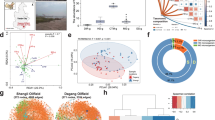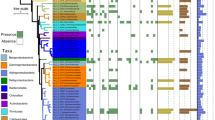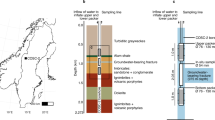Abstract
There are distinct differences in the physiology of Geobacter species available in pure culture. Therefore, to understand the ecology of Geobacter species in subsurface environments, it is important to know which species predominate. Clone libraries were assembled with 16S rRNA genes and transcripts amplified from three subsurface environments in which Geobacter species are known to be important members of the microbial community: (1) a uranium-contaminated aquifer located in Rifle, CO, USA undergoing in situ bioremediation; (2) an acetate-impacted aquifer that serves as an analog for the long-term acetate amendments proposed for in situ uranium bioremediation and (3) a petroleum-contaminated aquifer in which Geobacter species play a role in the oxidation of aromatic hydrocarbons coupled with the reduction of Fe(III). The majority of Geobacteraceae 16S rRNA sequences found in these environments clustered in a phylogenetically coherent subsurface clade, which also contains a number of Geobacter species isolated from subsurface environments. Concatamers constructed with 43 Geobacter genes amplified from these sites also clustered within this subsurface clade. 16S rRNA transcript and gene sequences in the sediments and groundwater at the Rifle site were highly similar, suggesting that sampling groundwater via monitoring wells can recover the most active Geobacter species. These results suggest that further study of Geobacter species in the subsurface clade is necessary to accurately model the behavior of Geobacter species during subsurface bioremediation of metal and organic contaminants.
Similar content being viewed by others
Log in or create a free account to read this content
Gain free access to this article, as well as selected content from this journal and more on nature.com
or
References
Altschul SF, Gish W, Miller W, Myers EW, Lipman DJ . (1990). Basic local alignment search tool. J Mol Biol 215: 403–410.
Amann RI, Binder BJ, Olson RJ, Chisholm SW, Devereux R, Stahl DA . (1990). Combination of 16S rRNA-targeted oligonucleotide probes with flow cytometry for analyzing mixed microbial populations. Appl Environ Microbiol 56: 1919–1925.
Anderson RT, Rooney-Varga J, Gaw CV, Lovley DR . (1998). Anaerobic benzene oxidation in the Fe(III)-reduction zone of petroleum-contaminated aquifers. Environ Sci Technol 32: 1222–1229.
Anderson RT, Vrionis HA, Ortiz-Bernad I, Resch CT, Long PE, Dayvault R et al. (2003). Stimulating the in situ activity of Geobacter species to remove uranium from the groundwater of a uranium-contaminated aquifer. Appl Environ Microbiol 69: 5884–5891.
Baedecker MJ, Siegel DI, Bennett P, Cozzarelli IM . (1989). The fate and effects of crude oil in a shallow aquifer I. The distribution of chemical species and geochemical facies. In: Mallard GE and Ragone SE (eds). US Geological Survey Water Resources Division Report 88-4220. US Geological Survey: Reston, VA, pp 13–20.
Brown NP, Leroy C, Sander C . (1998). MView: a web-compatible database search or multiple alignment viewer. Bioinformatics 14: 380–381.
Caccavo F, Lonergan DJ, Lovley DR, Davis M, Stolz JF, McInerney MJ . (1994). Geobacter sulfurreducens sp. Nov., a hydrogen- and acetate-oxidizing dissimilatory metal-reducing microorganism. Appl Environ Microbiol 60: 3752–3759.
Chang YJ, Long PE, Geyer R, Peacock AD, Resch CT, Sublette K et al. (2005). Microbial incorporation of 13C-labeled acetate at the field scale: detection of microbes responsible for reduction of U(VI). Environ Sci Technol 39: 9039–9048.
Childers SE, Ciufo S, Lovley DR . (2002). Geobacter metallireducens accesses insoluble Fe(III) oxide by chemotaxis. Nature 416: 767–769.
Church P, Armstrong D, Granato G, Stone V, Smith K, Provencher P . (1996). Effectiveness of Highway-Drainage Systems in Preventing Contamination of Ground water by Road Salt, Route 25, Southeastern Massachusetts—Description of Study Area, Data Collection Programs, and Methodology. US Geological Survey.
Coates JD, Bhupathiraju VK, Achenbach LA, McLnerney MJ, Lovley DR. (2001). Geobacter hydrogenophilus, Geobacter chapellei and Geobacter grbiciae, three new, strictly anaerobic, dissimilatory Fe(III)-reducers. IJSEM 51: 581–588.
Coates JD, Ellis DJ, Roden E, Gaw K, Blunt-Harris EL, Lovley DR . (1998). Recovery of humics-reducing bacteria from a diversity of sedimentary environments. Appl Environ Microbiol 64: 1504–1509.
Coppi MV, Leang C, Sandler SJ, Lovley DR . (2001). Development of a genetic system for Geobacter sulfurreducens. Appl Environ Microbiol 67: 3180–3187.
Cozzarelli IM, Eaganhouse RP, Baedecker MJ . (1990). Transformation of monoaromatic hydrocarbons to organic acids in anoxic groundwater environment. Environ Geol Water Sci 16: 135–141.
Eden PE, Schmidt TM, Blakemore RP, Pace NR . (1991). Phylogenetic analysis of Aquaspirillum magnetotacticum using polymerase chain reaction-amplified 16S rRNA-specific DNA. Int J Syst Bacteriol 41: 324–325.
Finneran K, Housewright M, Lovley DR . (2002). Multiple influences of nitrate on uranium solubility during bioremediation of uranium-contaminated subsurface sediments. Environ Microbiol 4: 510–516.
Holm PE, Nielsen PH, Albrechtsen HJ, Christensen TH . (1992). Importance of unattached bacteria and bacteria attached to sediment in determining potentials for degradation of xenobiotic organic contaminants in an aerobic aquifer. Appl Environ Microbiol 58: 3020–3026.
Holmes DE, Bond DR, Lovley DR . (2004a). Electron transfer by Desulfobulbus propionicus to Fe(III) and graphite electrodes. Appl Environ Microbiol 70: 1234–1237.
Holmes DE, Finneran KT, O'Neil RA, Lovley DR . (2002). Enrichment of members of the family Geobacteraceae associated with stimulation of dissimilatory metal reduction in uranium-contaminated aquifer sediments. Appl Environ Microbiol 68: 2300–2306.
Holmes DE, Nevin KP, Lovley DR . (2004b). In situ expression of nifD in Geobacteraceae in subsurface sediments. Appl Environ Microbiol 70: 7251–7259.
Holmes DE, Nevin KP, O'Neil RA, Ward JE, Adams LA, Woodard TL et al. (2005). Potential for quantifying expression of the Geobacteraceae citrate synthase gene to assess the activity of Geobacteraceae in the subsurface and on current-harvesting electrodes. Appl Environ Microbiol 71: 6870–6877.
Hult MF . (1984). Ground-Water Contamination by Crude Oil at Bemidji, Minnesota Research Site. US Geological Survey Toxic Waste—Ground-Water Contamination Study. US Geological Survery Water-Resources Investigations Report 84-4188, 107pp.
Kovacik Jr WP, Takai K, Mormile MR, McKinley JP, Brockman FJ, Fredrickson JK et al. (2006). Molecular analysis of deep subsurface cretaceous rock indicates abundant Fe(III)- and S(zero)-reducing bacteria in a sulfate-rich environment. Environ Microbiol 8: 141–155.
Lane DL, Pace B, Olsen GJ, Stahl D, Sogin ML, Pace NR . (1985). Rapid determination of 16S ribosomal RNA sequences for phylogenetic analysis. Proc Nat Acad Sci USA 82: 6955–6959.
Lee SH, Kim BJ, Kim JH, Park KH, Kim SJ, Kook YH . (2000). Differentiation of Borrelia burgdorferi sensu lato on the basis of RNA polymerase gene (rpoB) sequences. J Clin Microbiol 38: 2557–2562.
Lehman RM, Colwell FS, Bala GA . (2001). Attached and unattached microbial communities in a simulated basalt aquifer under fracture- and porous-flow conditions. Appl Environ Microbiol 67: 2799–2809.
Lehman RM, O'Connell SP, Banta A, Fredrickson JK, Reysenbach AL, Kieft TL et al. (2004). Microbiological comparison of core and groundwater samples collected from a fractured basalt aquifer with that of dialysis chambers incubated in situ. Geomicrobiol J 21: 169–182.
Lin B, Braster M, van Breukelen BM, van Verseveld HW, Westerhoff HV, Roling WF . (2005). Geobacteraceae community composition is related to hydrochemistry and biodegradation in an iron-reducing aquifer polluted by a neighboring landfill. Appl Environ Microbiol 71: 5983–5991.
Lovley DR . (1995). Bioremediation of organic and metal contaminants with dissimilatory metal reduction. J Industr Microbiol 14: 85–93.
Lovley DR . (2003). Cleaning up with genomics: applying molecular biology to bioremediation. Nat Rev Microbiol 1: 35–44.
Lovley DR . (2006). Bug juice: harvesting electricity with microorganisms. Nat Rev Microbiol 4: 497–508.
Lovley DR, Baedecker MJ, Lonergan DJ, Cozzarelli IM, Phillips EJP, Siegel DI . (1989). Oxidation of aromatic contaminants coupled to microbial iron reduction. Nature 339: 297–299.
Lovley DR, Fraga JL, Coates JD, Blunt-Harris EL . (1999). Humics as an electron donor for anaerobic respiration. Environ Microbiol 1: 89–98.
Lovley DR, Giovannoni SJ, White DC, Champine JE, Phillips EJP, Gorby YA et al. (1993). Geobacter metallireducens gen. nov. sp. nov., a microorganism capable of coupling the complete oxidation of organic compounds to the reduction of iron and other metals. Arch Microbiol 159: 336–344.
Lovley DR, Holmes DE, Nevin KP . (2004). Dissimilatory Fe(III) and Mn(IV) reduction. Adv Microb Physiol 49: 219–286.
Lovley DR, Phillips EJP . (1987). Rapid assay for microbially reducible ferric iron in aquatic sediments. Appl Environ Microbiol 53: 1536–1540.
Lovley DR, Phillips EJP . (1988a). Manganese inhibition of microbial iron reduction in anaerobic sediments. Geomicrobiol J 6: 145–155.
Lovley DR, Phillips EJP . (1988b). Novel mode of microbial energy metabolism: organic carbon oxidation coupled to dissimilatory reduction of iron or manganese. Appl Environ Microbiol 54: 1472–1480.
Lovley DR, Phillips EJP . (1994). Novel processes for anoxic sulfate production from elemental sulfur by sulfate-reducing bacteria. Appl Environ Microbiol 60: 2394–2399.
Mahadevan R, Bond DR, Butler JE, Esteve-Nunez A, Coppi MV, Palsson BO et al. (2006). Characterization of metabolism in the Fe(III)-reducing organism Geobacter sulfurreducens by constraint-based modeling. Appl Environ Microbiol 72: 1558–1568.
Methe BA, Nelson KE, Eisen JA, Paulsen IT, Nelson W, Heidelberg JF et al. (2003). Genome of Geobacter sulfurreducens: metal reduction in subsurface environments. Science 302: 1967–1969.
Mouser PJ, Rizzo DM, Roling WF, Van Breukelen BM . (2005). A multivariate statistical approach to spatial representation of groundwater contamination using hydrochemistry and microbial community profiles. Environ Sci Technol 39: 7551–7559.
Nevin KP, Holmes DE, Woodard TL, Hinlein ES, Ostendorf DW, Lovley DR . (2005). Geobacter bemidjiensis sp. nov. and Geobacter psychrophilus sp. nov., two novel Fe(III)-reducing subsurface isolates. Int J Syst Evol Microbiol 55: 1667–1674.
Nevin KP, Lovley DR . (2000). Lack of production of electron-shuttling compounds or solubilization of Fe(III) during reduction of insoluble Fe(III) oxide by Geobacter metallireducens. Appl Environ Microbiol 66: 2248–2251.
North NN, Dollhopf SL, Petrie L, Istok JD, Balkwill DL, Kostka JE . (2004). Change in bacterial community structure during in situ biostimulation of subsurface sediment cocontaminated with uranium and nitrate. Appl Environ Microbiol 70: 4911–4920.
Ostendorf D . (1997–2004). Series of Monthly Progress Reports. Highway Deicing Agent Impacts on Soil and Groundwater Quality Prepared under ISA 7721 and ISA 9775 for The Massachusettts Highway Department.
Pearson WR . (1990). Rapid and sensitive sequence comparisons with FASTP and FASTA. Meth Enzymol 183: 63–98.
Pedersen K, Ekendahl S . (1990). Distribution and activity of bacteria in deep granitic groundwaters of southeastern Sweden. Microb Ecol 20: 37–52.
Petrie L, North NN, Dollhopf SL, Balkwill DL, Kostka JE . (2003). Enumeration and characterization of iron(III)-reducing microbial communities from acidic subsurface sediments contaminated with uranium(VI). Appl Environ Microbiol 69: 7467–7479.
Reardon CL, Cummings DE, Petzke LM, Kinsall BL, Watson DB, Peyton BM et al. (2004). Composition and diversity of microbial communities recovered from surrogate minerals incubated in an acidic uranium-contaminated aquifer. Appl Environ Microbiol 70: 6037–6046.
Reguera G, McCarthy KD, Mehta T, Nicoll JS, Tuominen MT, Lovley DR . (2005). Extracellular electron transfer via microbial nanowires. Nature 435: 1098–1101.
Roling WF, van Breukelen BM, Braster BL, van Verseveld HW . (2001). Relationships between microbial community structure and hydrochemistry in a landfill leachate-polluted aquifer. Appl Environ Microbiol 67: 4619–4629.
Roling WF, van Breukelen BM, Braster M, Goeltom MT, Groen J, van Verseveld HW . (2000). Analysis of microbial communities in a landfill leachate polluted aquifer using a new method for anaerobic physiological profiling and 16S rDNA based fingerprinting. Microb Ecol 40: 177–188.
Rooney-Varga JN, Anderson RT, Fraga JL, Ringelberg D, Lovley DR . (1999). Microbial communities associated with anaerobic benzene degradation in a petroleum-contaminated aquifer. Appl Environ Microbiol 65: 3056–3063.
Schink B . (1984). Fermentation of 2,3-butanediol by Pelobacter carbinolicus sp. nov. and Pelobacter propionicus sp. nov., and evidence for propionate formation from C2 compounds. Arch Microbiol 137: 33–41.
Straub KL, Buchholz-Cleven BE . (2001). Geobacter bremensis sp. nov. and Geobacter pelophilus sp. nov., two dissimilatory ferric-iron-reducing bacteria. IJSEM 51: 1805–1808.
Swofford DL . (1998). PAUP*. Phylogenetic Analysis Using Parsimony (*and other methods) Version 4. Sinauer Associates: Sunderland, MA.
Thompson JD, Gibson TJ, Plewniak F, Jeanmougin F, Higgins DG . (1997). The CLUSTAL_X windows interface: flexible strategies for multiple sequence alignment aided by quality analysis tools. Nucleic Acids Res 25: 4876–4882.
Thompson JD, Higgins DG, Gibson TJ . (1994). CLUSTAL W: improving the sensitivity of progressive multiple sequence alignment through sequence weighting, positions-specific gap penalties and weight matrix choice. Nucleic Acids Res 22: 4673–4680.
Vrionis HA, Anderson RT, Ortiz-Bernad I, O'Neill KR, Resch CT, Peacock AD et al. (2005). Microbiological and geochemical heterogeneity in an in situ uranium bioremediation field site. Appl Environ Microbiol 71: 6308–6318.
Acknowledgements
We thank the DOE Joint Genome Institute for providing us with preliminary sequence data from G. metallireducens, G. uraniumreducens, G. bemidjiensis, G. sp. FRC-32, G. lovleyi, P. carbinolicus, P. propionicus and D. acetoxidans. This research was supported by the Office of Science (BER), US Department of Energy with funds from the Environmental Remediation Science Program (grants DE-FG02ER06-12 and DE-FG02-97ER62475) and the Genomes to Life Program (cooperative agreement No. DE-FC02-02ER63446).
Author information
Authors and Affiliations
Corresponding author
Rights and permissions
About this article
Cite this article
Holmes, D., O'Neil, R., Vrionis, H. et al. Subsurface clade of Geobacteraceae that predominates in a diversity of Fe(III)-reducing subsurface environments. ISME J 1, 663–677 (2007). https://doi.org/10.1038/ismej.2007.85
Received:
Revised:
Accepted:
Published:
Issue date:
DOI: https://doi.org/10.1038/ismej.2007.85
Keywords
This article is cited by
-
Comparative metatranscriptomics reveals extracellular electron transfer pathways conferring microbial adaptivity to surface redox potential changes
The ISME Journal (2018)
-
Potential for Methanosarcina to Contribute to Uranium Reduction during Acetate-Promoted Groundwater Bioremediation
Microbial Ecology (2018)
-
Anaerobic degradation of 1-methylnaphthalene by a member of the Thermoanaerobacteraceae contained in an iron-reducing enrichment culture
Biodegradation (2018)
-
Abundance and diversity of iron reducing bacteria communities in the sediments of a heavily polluted freshwater lake
Applied Microbiology and Biotechnology (2018)
-
The influence of soil properties and geographical distance on the bacterial community compositions of paddy soils enriched on SMFC anodes
Journal of Soils and Sediments (2018)



